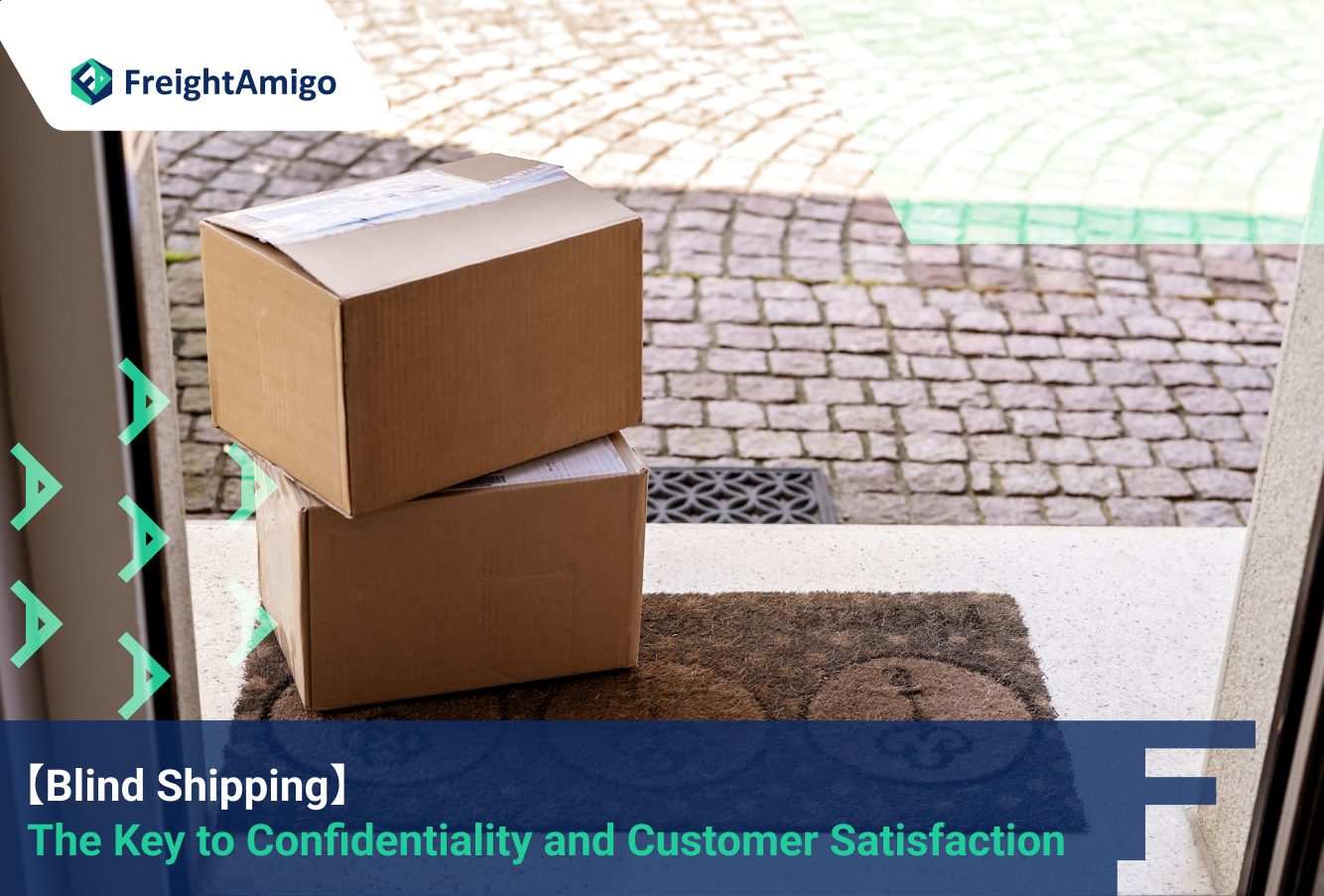22nd January, 2024 Caspian Ng – Marketing Analyst at FreightAmigo
Blind shipping is a popular method used by businesses to ensure confidentiality and enhance customer satisfaction in the supply chain. This article will provide a comprehensive understanding of blind shipping for your business, its benefits, and how it can be implemented.
Want to compare the best Express, Air Freight, Sea Freight, Rail Freight & Trucking rates so as to have better control on cost?
What is blind shipping and how does it work?
Blind shipping is a technique in which the supplier ships a product directly to the customer without revealing the supplier’s identity. Instead of using their own packaging and labeling, the supplier uses the customer’s branding, making it appear as if the product came directly from the customer. This creates the illusion that the customer is the original sender, providing a sense of confidentiality.
The process of blind shipping involves three parties: the supplier, the customer, and the end recipient. The supplier receives an order from the customer and ships the product directly to the end recipient. The supplier ensures that their identity is concealed throughout the process, maintaining the confidentiality of the transaction.
The difference between blind shipping and drop shipping
Blind shipping is often confused with drop shipping, but there is a fundamental difference between the two. In drop shipping, the supplier ships the product directly to the customer on behalf of the retailer. However, the customer is aware of the supplier’s involvement in the transaction. In blind shipping, the supplier’s identity is completely hidden from the customer and the end recipient, creating an additional layer of confidentiality.
While drop shipping allows the customer to track the shipment and communicate directly with the supplier, blind shipping keeps the supplier’s involvement discreet. This distinction is vital for businesses that value confidentiality and want to maintain a seamless customer experience.
Benefits of blind shipping for businesses
Blind shipping offers several benefits for businesses in various industries. Firstly, it allows businesses to expand their product offerings without investing in additional inventory. By partnering with suppliers who offer blind shipping services, businesses can provide a wider range of products to their customers without the need to stock and manage inventory themselves.
Secondly, blind shipping reduces shipping costs and transit time. Since the product is shipped directly from the supplier to the end recipient, there are no intermediate stops or additional handling, resulting in faster delivery times and lower shipping costs.
Furthermore, blind shipping eliminates the need for businesses to invest in warehousing and fulfillment infrastructure. By outsourcing the shipping process to the supplier, businesses can focus on their core competencies and allocate resources more efficiently.
How blind shipping improves confidentiality
Confidentiality is crucial for businesses, especially when dealing with sensitive products or working with high-profile clients. Blind shipping ensures that the supplier’s identity remains hidden from both the customer and the end recipient, providing an added layer of confidentiality.
By concealing the supplier’s identity, businesses can protect their trade secrets, pricing strategies, and sourcing information. This is particularly important when working with competitors or in industries where maintaining confidentiality is paramount.
Moreover, blind shipping helps businesses build trust with their customers. When customers receive a package that appears to come directly from the business, it creates a seamless experience and enhances the perception of reliability. Customers feel more confident knowing that their personal information is protected and that the business takes their privacy seriously.
Enhancing customer satisfaction through blind shipping
Blind shipping plays a crucial role in enhancing customer satisfaction. By utilizing blind shipping, businesses can provide a seamless and personalized experience to their customers.
When customers receive a package that is branded with their own company logo and address, it creates a sense of exclusivity and professionalism. This personalized touch can leave a lasting impression on customers and increase their loyalty towards the business.
Moreover, blind shipping allows businesses to offer faster delivery times. By eliminating the need for intermediate warehousing and handling, products can be shipped directly from the supplier to the end recipient, reducing transit time and ensuring prompt delivery. This improves customer satisfaction and increases the likelihood of repeat business.
The role of blind shipping in the supply chain
Blind shipping plays a vital role in the supply chain, especially for businesses that rely on third-party suppliers. It allows businesses to streamline their operations by outsourcing the shipping process to the supplier.
By implementing blind shipping, businesses can reduce logistics complexity and minimize the risk of errors in the supply chain. With the supplier directly responsible for shipping, businesses can focus on other aspects of their operations, such as marketing, sales, and customer service.
Blind shipping also enables businesses to expand their reach and serve customers in remote locations. By partnering with suppliers who offer blind shipping services, businesses can deliver their products to customers worldwide, regardless of their geographical location.
Implementing blind shipping in your business
Implementing blind shipping in your business requires careful planning and coordination with the suppliers. Here are some steps to consider:
- Identify suppliers: Look for suppliers who offer blind shipping services and have experience in your industry. Conduct thorough research and evaluate their track record to ensure they can meet your requirements.
- Establish confidentiality agreements: Work with your suppliers to establish confidentiality agreements that protect your trade secrets, pricing strategies, and other sensitive information. Ensure that these agreements are legally binding and enforceable.
- Customize packaging and labeling: Collaborate with your suppliers to create customized packaging and labeling solutions that reflect your brand identity. This will help maintain consistency and enhance the customer experience.
- Test the process: Before fully implementing blind shipping, conduct a trial run to identify any potential issues or challenges. This will allow you to fine-tune the process and ensure a seamless experience for your customers.
- Monitor and optimize: Continuously monitor the blind shipping process and gather feedback from your customers. Use this feedback to optimize the process and address any issues that may arise.
Challenges and considerations of blind shipping
While blind shipping offers numerous benefits, there are also challenges and considerations that businesses need to be aware of. These include:
- Supplier reliability: Businesses must carefully select suppliers that are reliable and trustworthy. The supplier’s performance directly impacts the customer experience, so it is essential to partner with suppliers who can consistently meet your expectations.
- Communication and tracking: Since the customer is unaware of the supplier’s involvement in the transaction, communication and tracking can become challenging. Implementing robust communication channels and tracking systems is essential to provide transparency and address any customer inquiries.
- Quality control: With blind shipping, the supplier is responsible for packaging and shipping the product. Ensuring the quality of the packaging and the accuracy of the shipment is crucial to maintain customer satisfaction. Regular audits and quality control checks are necessary to address any potential issues.
Conclusion: The future of blind shipping
Blind shipping is an effective strategy for businesses looking to enhance confidentiality and customer satisfaction. By implementing blind shipping, businesses can expand their product offerings, reduce shipping costs, and improve the overall customer experience. As technology continues to advance, the future of blind shipping looks promising. With the integration of advanced tracking systems and improved communication channels, businesses will be able to provide even greater transparency and efficiency in the blind shipping process. By embracing blind shipping, businesses can gain a competitive edge in today’s fast-paced and customer-centric market. It is a strategic approach that not only ensures confidentiality but also enhances customer satisfaction, leading to long-term success.
There are different options for cargo transportation. If you want to choose the most convenient and suitable solution, it is best to have the full support of logistics experts for your supply chain management!
===
Read More:
【Logistic101】 What role the order fulfilment plays in a supply chain?
【Import from Europe】 Streamlining Your Supply Chain Operations
===
If you have any inquiries on logistics/supply chain, feel free to contact FreightAmigo now:
Chat with us online | Hotline: +852 28121686 | WhatsApp: +852 27467829





































